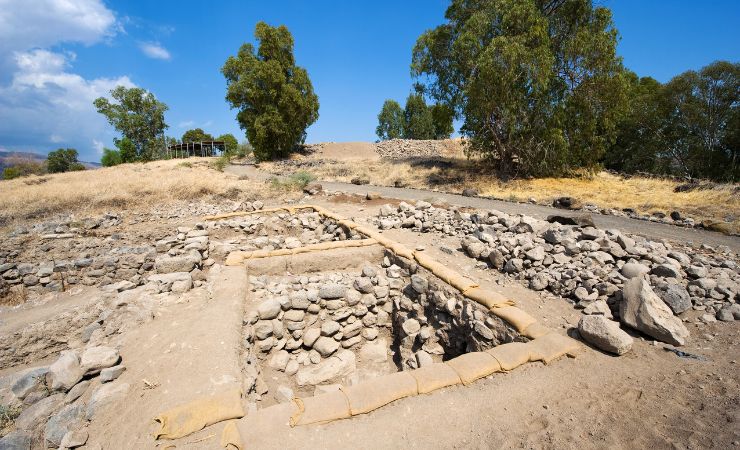Bethsaida: Home of Three of the Apostles
Bethsaida is also known as Beit Saida. The name is derived from the Hebrew/Aramaic term “בית צידה” (beth-tsaida), which translates to “house of hunting”. In Hebrew, “beit” means house, while “tzed” can mean both hunting and fishing. This gives the name a dual interpretation, suggesting it could mean either “house of the fisherman” or “house of the hunter”.

Location
Bethsaida (Beit Saida) is located near the northeastern shore of the Sea of Galilee.
Bethsaida in the Bible
Bethsaida is the third most mentioned city in the gospels after Jerusalem and Capernaum. It is believed to be the hometown of three of Jesus’ apostles: Philip, Peter, and Andrew. According to the New Testament, particularly the Gospel of John, Bethsaida was the birthplace of these apostles. The town was situated near where the Jordan River flows into the Sea of Galilee on the northern side of the sea. Bethsaida holds a significant place in the New Testament. It is associated with several miracles performed by Jesus:
Feeding of the 5,000: It is believed that the miraculous feeding of the 5,000 took place at Tabgha, near Bethsaida. The Church of the Multiplication stands at that location.
Walking on Water: One of Jesus’ most renowned miracles, walking on water, occurred as He was on His way to Bethsaida.
Healing of the Blind Man: In the Gospel of Mark, Jesus restored the sight of a blind man just outside the town.
Bethsaida was the scene of numerous miracles. However, despite witnessing these miracles, the inhabitants did not repent. In this context, it represents those who have heard the gospel, understood God’s plan of salvation, but chose to reject it.
Around 30 CE, Herod Philip, the son of Herod the Great, transformed Bethsaida, a fishing village, into a city (polis). Josephus, the Jewish historian, reports that Herod Philip renamed the site “Julias” and enhanced its population and grandeur. This city persisted for several centuries before vanishing from historical records.
Bethesda and Bethsaida are Not the Same!
No, they are not the same. They are distinct places with different historical and biblical significances. Bethesda is the known as the Pool of Bethesda where Jesus healed a paralyzed man (John 5:1-15). See a comparison between the two sites.



Archeological Findings at Bethsaida
Dr. Rami Arav, the excavator of Et-Tell, is confident that Bethsaida is located at Et-Tell. He has discovered remains from the Hellenistic and Early Roman periods (second century BC to AD 65/66) at this site. Some of the archaeological findings at Et-Tell include:
City Gates and Walls: One of the significant discoveries at Et-Tell is the city gate from the Iron Age, which is believed to be one of the largest gates found in the region from this period. This discovery supports the idea that Bethsaida was a significant city during the Iron Age.
Streets and Public Buildings: The layout of streets and the remnants of public buildings provide clues about the city’s structure and its significance during various periods.
Ancient Dwellings: Excavations have uncovered several houses and dwellings, providing insights into the daily life of the inhabitants.
Fishing Equipment: Given its proximity to the Sea of Galilee and its name’s meaning (“house of fishing”), it’s not surprising that remnants of ancient fishing equipment, including weights and hooks, have been found.
Coins and Pottery: Numerous coins from the Hellenistic and Roman periods have been unearthed, along with a variety of pottery shards, which help date the different occupation layers of the site.
Religious Artifacts: Various religious artifacts, including figurines and altars, have been discovered, shedding light on the religious practices and beliefs of the inhabitants.
Nearby Sites
- Capernaum: Also known as the “Town of Jesus”. This is where Jesus performed many of his miracles. The Church of the Twelve Apostles is based in Capernaum.
- Kursi: Believed to be the location of the “Miracle of the Swine” performed by Jesus in the New Testament.
- Hippos-Sussita: An ancient city that was part of the Decapolis during the Hellenistic and Roman periods.
- Mount of Beatitudes: A hill where Jesus delivered the Sermon on the Mount. It currently houses the Church of Beatitudes designed by Antonio Barluzzi.
- Tabgha: Tabgha is believed to be the site of Jesus’ miracle of feeding the 5,000.
- Domus Galilaeae: Aspiritual retreat overlooking the Sea of Galilee in Israel, offers a serene sanctuary for reflection and prayer.



